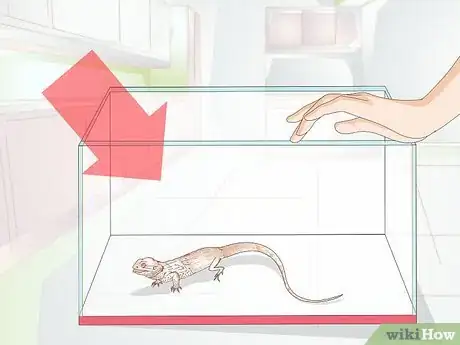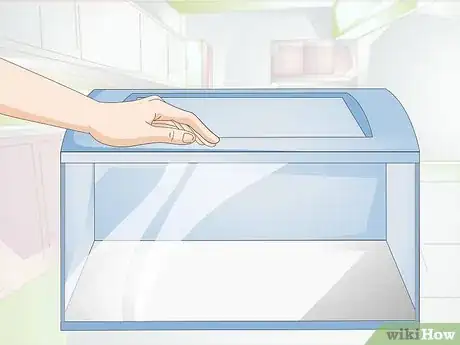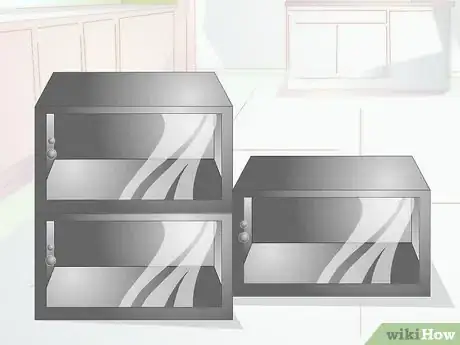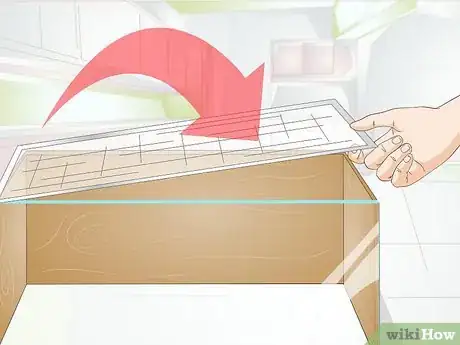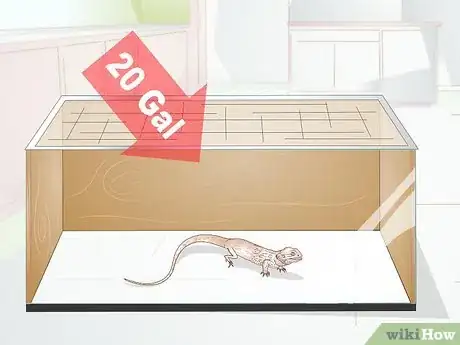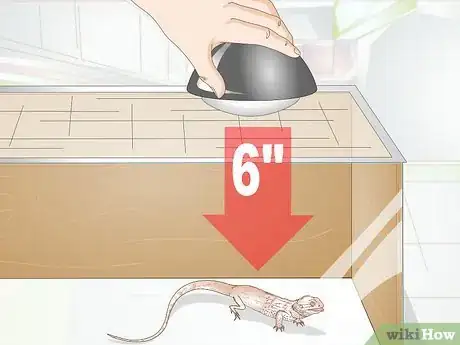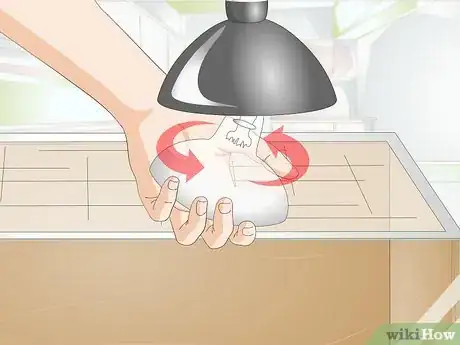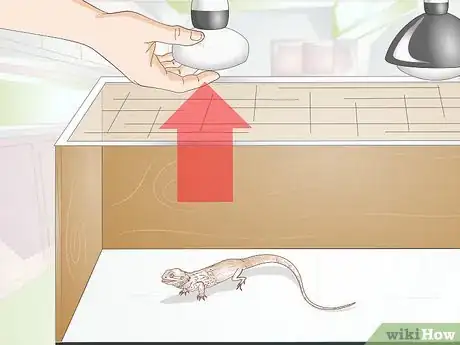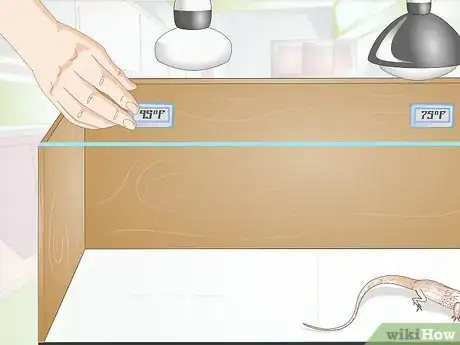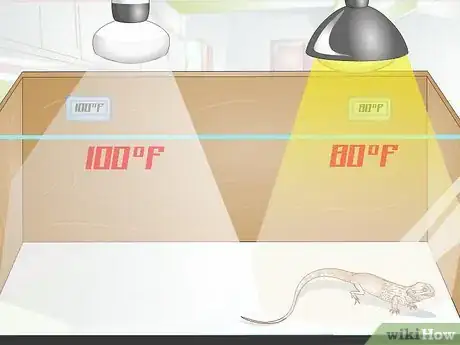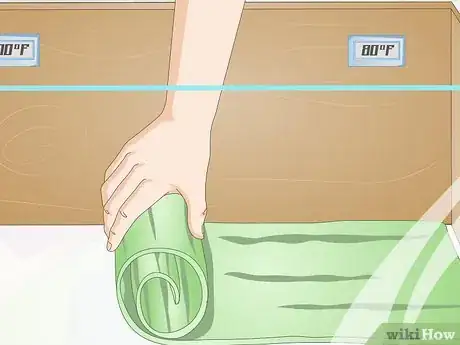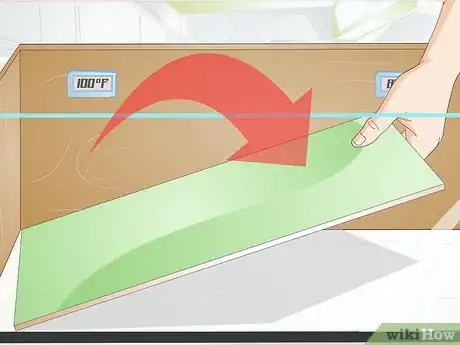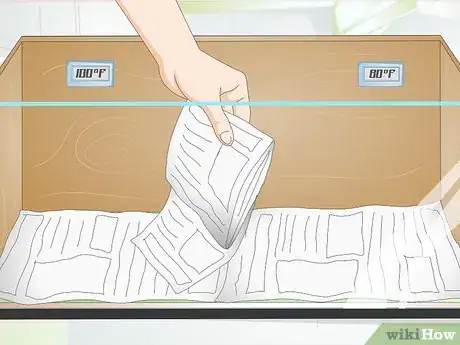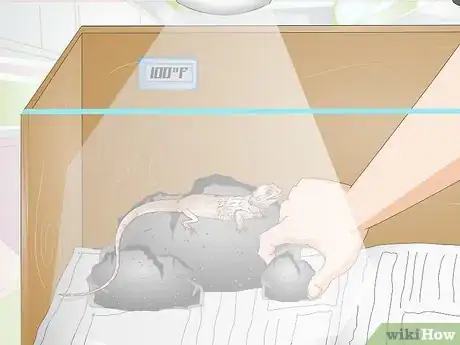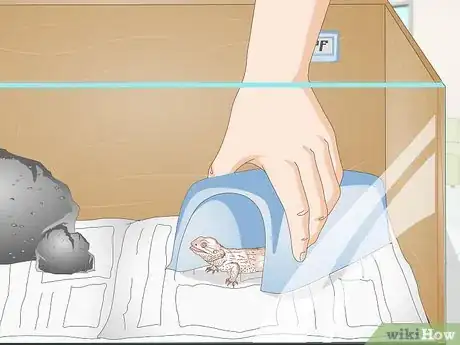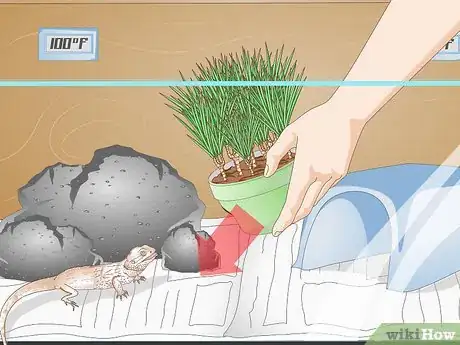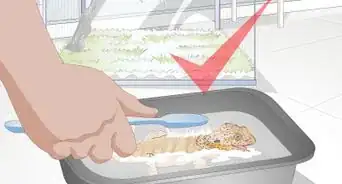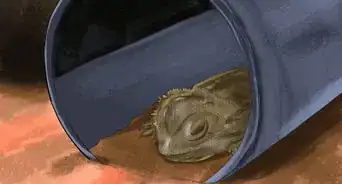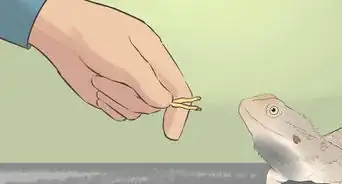This article was co-authored by Pippa Elliott, MRCVS. Dr. Elliott, BVMS, MRCVS is a veterinarian with over 30 years of experience in veterinary surgery and companion animal practice. She graduated from the University of Glasgow in 1987 with a degree in veterinary medicine and surgery. She has worked at the same animal clinic in her hometown for over 20 years.
There are 11 references cited in this article, which can be found at the bottom of the page.
wikiHow marks an article as reader-approved once it receives enough positive feedback. In this case, 85% of readers who voted found the article helpful, earning it our reader-approved status.
This article has been viewed 81,671 times.
Bearded dragons are great pets. However, setting up their habitat takes planning and careful consideration of their needs. In addition to choosing what kind of tank you want, you'll have to select the right lighting, decor, and monitor the temperature. Keep your bearded dragon happy by giving it the best home you can.
Steps
Choosing the Right Tank
-
1Choose a glass aquarium. This is the most common type of tank for bearded dragons. Glass aquariums are inexpensive and easy to find at local pet stores or on local market sites like Craigslist. The only downsides are that they are heavy and not well insulated. A heavy tank can be difficult to move and once it's set up with the dragon inside, you'll not be inclined to move it. And while bearded dragons might not mind the lack of insulation, some owners complain that a lower temperature dulls the reptile's color.[1]
-
2Choose a melamine cage. Melamine cages are made of melamine board, a kind of wood coated with a laminate finish. You can build a melamine cage yourself or buy one at your local pet store.[2] These types of cages replicate the zoo-going experience. Unfortunately, this means the lizard can only be seen from one side of the enclosure.
- You can leave the boards within the cage plain white to reflect light, or choose to affix an artificial rock surface to the back and side of the cage to replicate a more natural environment.
Advertisement -
3Choose a PVC cage. A PVC cage is made of a kind of plastic and therefore much easier to move than a melamine cage. They are, unfortunately, more expensive than melamine, but many people find that the PVC plastic looks better than the melamine board cage.[3]
-
4Choose a professional cage. There are several high-end companies that make quality cages for reptiles. These cages are professional-grade and made of one molded piece of plastic. They are quite expensive but many breeders favor them because they are conveniently stackable.[4] Chemically resistant, easy to clean, and shipped with a built-in heat lamp, professional cages are the best cages available.
-
5Ensure your tank has an appropriate lid. Do not use solid lids of plastic or glass. These can limit airflow in your dragon's tank.[5] Bearded dragons come from very dry, arid regions in Australia where there is little humidity. A firmly closed lid will lead to an unhealthy increase in humidity.
-
6Ensure your dragon has enough room. The size of your tank depends on how large your dragon is.[6] The larger your dragon, the bigger the cage it will need. Baby dragons, for instance, need a 20 gallon tank. Larger (10-16 inch) dragons will need a tank of at least 40 gallons.
- It doesn't hurt to get a tank larger than the minimums listed above. Doing so will make your dragon happy.
- It's a good idea to get the largest tank you expect you'll need, rather than working up through progressively larger tanks. For instance, instead of starting with a small 20 gallon tank and then buying larger 40, 50, or 75 gallon tanks as your dragon grows, just spring for the 75 or 120 gallon tank and let your dragon grow into it.
Meeting Heat and Light Requirements
-
1Install a full-spectrum light in your dragon's tank.[7] A full-spectrum light emits regular visible light that helps us see, plus other ranges in the ultraviolet spectrum (UVA and UVB) which dragons need to stay healthy. Your light needs to be in a location where the lizard can come within six to eight inches of it. If your light is located in an overhead position more than six to eight inches from the floor of the tank, provide a rock or branch which your lizard can climb to move closer to the light.
-
2Change your UVA/UVB bulbs frequently. Over time, UVA/UVB lights become less effective. Even if your bulbs seem to be operating in good condition, change them every six months in order to keep your lizard healthy.[8]
-
3Include a basking light in your dragon's cage. In addition to the full-spectrum light, you will need to provide a source of hot light. This basking light should be a bright white and can be bought either at local hardware stores or from a pet store. Be sure you provide room for this light in addition to the full-spectrum light (which usually runs the whole length of the cage) when setting up your bearded dragon's tank.
- Install the basking light at one end of the tank. This way, the dragon will have a warm side and a cool side of the tank.
- Alternatives to the basking bulb include a ceramic heater or a household bulb that puts out a lot of heat (any old-style rounded bulb will do).
-
4Install two temperature gauges in the tank. Install one temperature gauge at the hot end near the basking bulb. Install the other at the opposite end where the temperature should be cooler. This way you can ensure that the basking lamp is doing its job. If you see that the temperature is uniform throughout the tank, replace your basking bulb.
- You could also install a humidity gauge to ensure that humid air is not accumulating in the tank.
- If your cage is small, you might be okay to install just one thermometer gauge.[9]
- Use small, round thermometer gauges available at your local pet store. They attach easily to the inside of the tank and are specially designed for reptile habitats.
- Additionally, invest in an infrared temperature gun or a digital thermometer with a probe end. Use it to monitor the temperature in your tank.
- Do not use traditional “stick” style thermometers; they are notoriously inaccurate.[10]
-
5Identify and maintain your target temperatures. The warm side of the tank should be at about 100 degrees Fahrenheit. The cooler side should be at about 80 degrees Fahrenheit. Be careful at night. The tank should never be below 70-75 degrees Fahrenheit. Check your tank at night; it can be hard to keep nighttime temperatures in the acceptable range.[11]
- If you're having trouble keeping the tank warm at night, invest in an under tank heater (UTH).
- You can also adjust the tank temperature by moving the basking light closer to or further from the tank.
Finding the Right Substrate
-
1Install reptile carpet. Reptile carpet is good for dragons of any age, but is the best choice for juveniles (dragons less than six inches long). Small bearded dragons might accidentally ingest more sand than their tiny lungs and stomachs can handle.
- For close substitutes, you could also use AstroTurf or indoor/outdoor carpet.[12]
-
2Install tile. Tile is easy to clean up and will easily outlast your bearded dragon. Regular slate or ceramic tile makes a good substrate for your dragon. It is nontoxic, inedible, and sturdy. You can get tiles at your local hardware store.[13]
-
3Drop some paper towel or newspaper in the tank. These materials are cheap and easy to replace. However, they do have to be replaced daily when they get wet or yucky. If you do not, your dragon might get sick and the tank will become uncomfortably humid.[14]
- If your dragon gets ill, you can lay newspaper and/or paper towel down until they are better. Doing so makes cleanup easy and is an important step in preventing infected fecal matter or vomit from re-infecting your sick dragon. Newspaper and/or paper towel are also useful when treating a dragon with parasites.[15]
-
4Avoid loose or particulate substrate.[16] Sand is often recommended as the ideal substrate. However, sand is messy and gets everywhere, including in the lizard's food and water. Because sand is so easily ingested by lizards, it is a leading cause of impaction, eye abscesses, and other ailments. Avoid substrates like sand, gravel, wood shavings, walnut shells, and other particulate substrate.[17]
- Besides the health risks sand poses for your bearded dragon, it is impractical in that it is difficult to clean.
Adding Decor
-
1Add a basking platform. A basking platform allows your dragon to get closer to the basking light in his or her cage. While you can buy a sturdy (if artificial-looking) structure, you might prefer to introduce a long branch or a rock over which your dragon can climb.[18]
-
2Add a hide.[19] A hide (or hide box) is a little hut or house into which your bearded dragon can crawl for extra warmth. Your dragon will also use the hide for brumation, the reptile equivalent of hibernation. And, like humans, sometimes bearded dragons just get shy and want some privacy away from prying eyes.
- Place the hide beneath the basking lamp to keep it warm inside.
- If your dragon isn't using its hide, try to move the location, or try a different type of hide.[20]
-
3Add some naturalistic elements. Give your tank a natural look by adding things like plastic cacti or flowers. You could also use real plants like Dracaena, Ficus benjamina, and hibiscus. If you do choose to use live plants, ensure they are nontoxic and have not been treated with biocides. Wash them thoroughly with a water spray and water them for a few weeks before introducing them into the tank with your bearded dragon.
- Artificial plants are the best choice since you'll never have to worry about them having any pesticides or bugs on them. Plus, you won't have to water them.[21]
References
- ↑ http://www.thebeardeddragon.org/bearded-dragon-setup.php
- ↑ http://www.thebeardeddragon.org/bearded-dragon-setup.php
- ↑ http://www.thebeardeddragon.org/bearded-dragon-setup.php
- ↑ http://www.thebeardeddragon.org/bearded-dragon-setup.php
- ↑ http://www.thebeardeddragon.org/bearded-dragon-setup.php
- ↑ http://www.thebeardeddragon.org/bearded-dragon-setup.php
- ↑ http://www.thebeardeddragon.org/bearded-dragon-setup.php
- ↑ http://www.thebeardeddragon.org/bearded-dragon-setup.php
- ↑ http://www.thebeardeddragon.org/bearded-dragon-setup.php
- ↑ https://www.beardeddragon.org/articles/newbies-guide-what-to-buy/?page=2#Tank/Enclosure
- ↑ http://www.thebeardeddragon.org/bearded-dragon-setup.php
- ↑ http://www.drsfostersmith.com/pic/article.cfm?articleid=820
- ↑ http://www.beardeddragoncare101.com/best-substrate-bearded-dragon/
- ↑ http://www.beardeddragoncare101.com/best-substrate-bearded-dragon/
- ↑ https://www.beardeddragon.org/articles/newbies-guide-what-to-buy/?page=2#Tank/Enclosure
- ↑ https://www.beardeddragon.org/articles/newbies-guide-what-to-buy/?page=2#Tank/Enclosure
- ↑ http://www.lizard-landscapes.com/Bearded-Dragon.html
- ↑ http://www.thebeardeddragon.org/bearded-dragon-setup.php
- ↑ http://www.thebeardeddragon.org/bearded-dragon-setup.php
- ↑ http://www.drsfostersmith.com/pic/article.cfm?articleid=820
- ↑ http://www.beardeddragoncare101.com/plants-decor-bearded-dragon-habitat/
- ↑ http://www.thebeardeddragon.org/bearded-dragon-setup.php
About This Article
To set up a tank for bearded dragons, start by choosing a glass aquarium or a PVC cage for your dragons, with a mesh screen lid to allow proper air circulation. Then, install a full-spectrum light to keep your dragons healthy, and a basking light to keep them warm. Next, put reptile carpet from your local pet or hardware store in the bottom of the tank, or lay down newspapers or paper towels as substrate. Finally, add artificial plants, rocks, and boxes or huts your dragons can hide in to make the tank a comfortable home. For more information from our Veterinary co-author, including how to set up and monitor warm and cool sides in your tank, read on!
